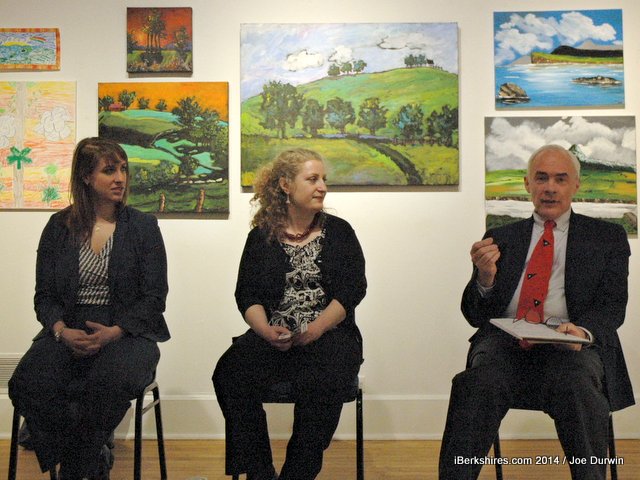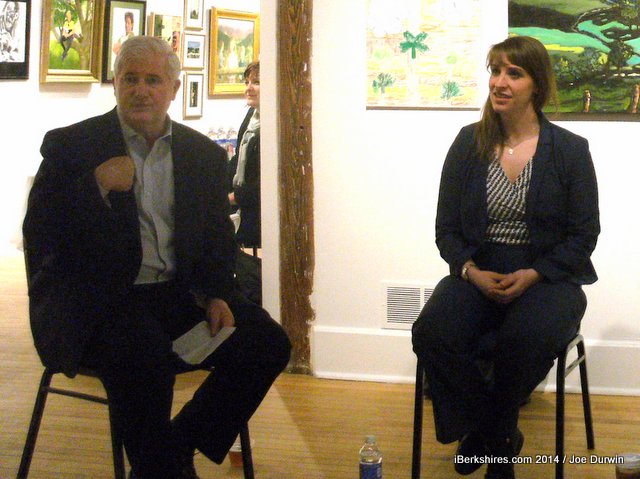Arts Experts Weigh Impact of Local Creative EconomyBy Joe Durwin, Pittsfield Correspondent
02:35PM / Friday, March 07, 2014 | |
 Helena Fruscio, left, Dee Schneidman and Stephen Sheppard discussed the the economic impact of creative industry in the state, including in the Berkshires, at the Lichtenstein Center on Wednesday. Helena Fruscio, left, Dee Schneidman and Stephen Sheppard discussed the the economic impact of creative industry in the state, including in the Berkshires, at the Lichtenstein Center on Wednesday. |
PITTSFIELD, Mass. — Cultural economics specialists from around the region examined both the benefits and challenges of cultivating creative industry in Berkshire County at a panel discussion on Wednesday at the Lichtenstein Center for the Arts.
The forum was one of three being held in the region this week.
Creatively moderated by Berkshire Museum Director Van Shields, panelists Williams College economist Stephen Sheppard, state Creative Economy Director Helena Fruscio and Dee Schneidman from the New England Foundation for the Arts delved into the measurable impact of the creative sector and some considerations for improving on that within the local economy.
Panelists emphasized that while numerous studies have confirmed the more obviously apparent economic effects of such cultural activity, many aspects remain difficult to quantify and definitions of what is encapsulated within the term "creative economy" are still fluid and varying.
"There's a diversity of views about what constitutes a creative economy," Sheppard said.
Sheppard said that because creative businesses and occupations benefit a multitude of industries in subtle ways, it can be difficult to chart the full extent of the economic results, though most studies show that the impact of cultural institutions on a local economy is about 2 1/2 times its own total operating budget.
For institutions that draw tourist visitors from other places to a local area, the quantification is somewhat clearer. For instance, Sheppard said that for every 100,000 visitors to the Berkshires, about $6 million in spending goes into the local economy.
"Keep in mind, we're bringing in a couple of million visitors to all the different institutions here," he noted. "So it does have a big impact."
Panelists agreed that while the economic downturn of recent years has hurt funding for arts and cultural endeavors, there is still plenty of room for optimism about the role of the creative industry.
"Because the recession has had such a broad impact on communities around the country, this is really an opportunity for communities who are looking for ways to create jobs, and keep students in their communities," said Schneidman. "There is a lot of opportunity for these partnerships.
"I think there's a real opportunity for a new polemic for how a community thrives," she added, "and the creative sector itself is not a drain on the community in any way, it's actually an asset."
"Economies, like other ecosystems that we encounter on this planet, do best when they have diversity," Sheppard said.
Collaboration, and in particular "clustering" of creative professionals and institutions is paramount, panelists agreed.
 Berkshire Museum Director Van Shields moderated the event. Berkshire Museum Director Van Shields moderated the event. |
"Clustering the creative economy is even more important in rural communities," said Fruscio, former director of Berkshire Creative. "Having close quarters, having a place and a destination to go to find these innovators can be really useful."
One intensive example of this kind of clustering is Maker Spaces, where artists, artisans, designers and others can work closely with each other, sharing resources and tools in a way that's more cost effective to the creative small-business model. Fruscio pointed out the popular Artisans Asylum in Somerville as one very successful example that was even drawing new residents to move to be in closer proximity.
"Not only in the creative economy but in all different aspects, clustering is really important in determining how well the nonprofit sector interacts with the overall local economy, and how it does it's work," added Sheppard, who said new research is illuminating similar trends in medical nonprofit services.
The panelists also pointed to an inherent challenge in maintaining perspective about the role of the creative economy in an area such as the Berkshires, where major cultural attractions have been part of the landscape, citing a need for better marketing and branding of that economy.
"New England reserve does not serve us in this situation," said Schneidman.
| 
 MEMBER SIGN IN
MEMBER SIGN IN
 MEMBER SIGN IN
MEMBER SIGN IN